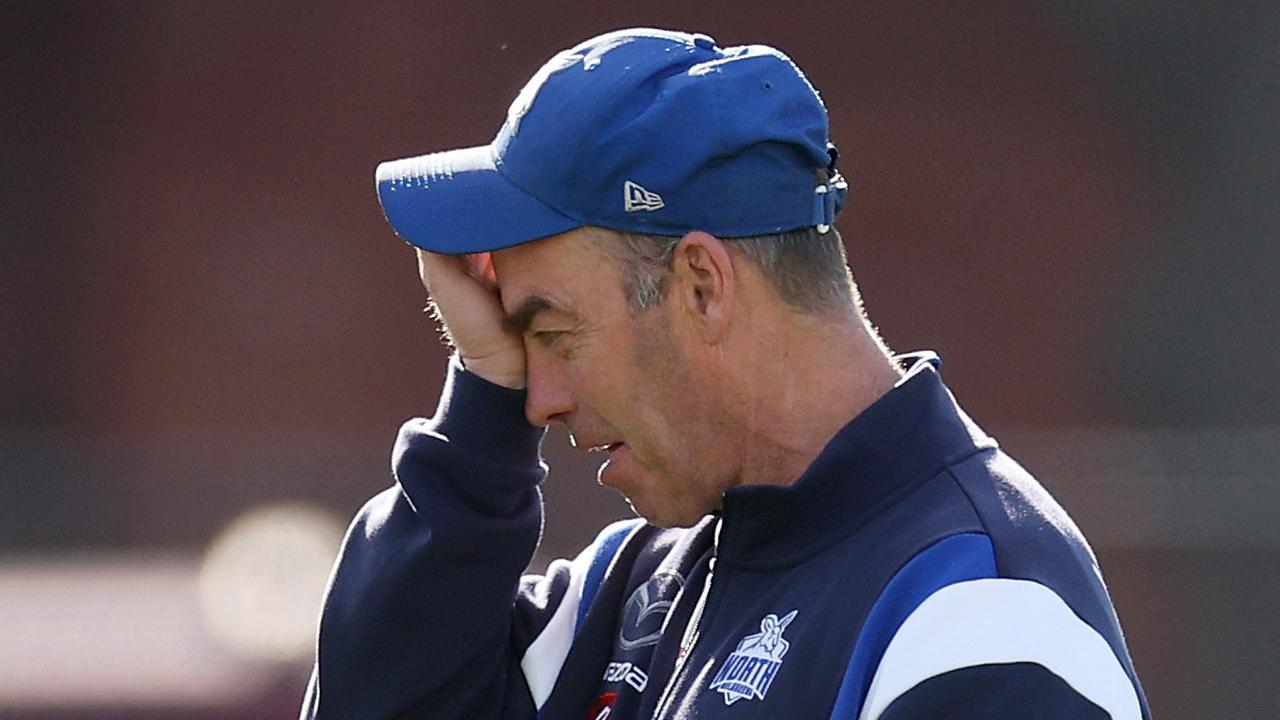Sydney Lions and East Coast Bears: the crazy shared history of Grand Final combatants
It will be an historical Grand Final with Sydney and Brisbane involved, but the paths previous iterations of the club took could have seen the ‘Sydney Lions’ or the ‘East Coast Bears’ playing in their place writes SHANNON GILL.

From an existence as two destitute neighbouring clubs, to the unloved, money haemorrhaging enterprises in a foreign territory, the path to a Sydney and Brisbane Grand Final has been an unlikely one.
Iterations of the two clubs passed through many sliding doors together from the late 1970s to the early 1990s and if things had been different we could have been watching the ‘Sydney Lions’ or even the ‘East Coast Bears’ playing in the big game.
Albert Park Amalgamation
In the late 1970s Fitzroy and South Melbourne were the most dollar and success-starved clubs in the VFL. They also happened to be neighbours.
South at its traditional Lake Oval home at the north end of the Albert Park Lake, and the nomadic ‘Roys at the south end Junction Oval.
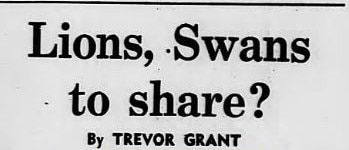
Then-Fitzroy board member and later President Leon Wiegard remembers a push from the VFL for the two clubs to consolidate their grounds and facilities, and perhaps more.
“The VFL formed an investigation into which ground would be the best if the two clubs shared or merged,” he says.
The suggestion led to the scenario of both clubs refusing to budge, but attempting to lure the other to the opposite end of the lake as a paying tenant.
The press called it the ‘Albert Park merry go-round’ as the Swans boasted of its successful bingo operations and the Lions of their superior ground surface. In the background were cricket club tenants complaining that they would be left in ruin if either of the football clubs moved.
“I was personally in favour of looking at it, but it came out marginally in favour of South Melbourne, which of course we didn’t accept,” Wiegard says.
“It was an official investigation, but it had no balls - there was nothing at the end of it.”
Ultimately neither went anywhere, yet the respective Presidents were united in their view that they were in trouble.
South Melbourne‘s boss George Camakaris summed it up by saying that “the problems facing us are more fundamental than sharing grounds. They relate to where we are going as a whole.”
“Sharing grounds would be just a little bit of oxygen to a dying man.”

Sydney Lions
Fitzroy President Frank Bibby was of the same mind and was looking further north than the lake - all the way to the harbour city, long before their red and white rivals would relocate there.
“It is implausible for Fitzroy to exist on the financial shoestring it has for the past few years. We have reached a situation where we have just got to do something.” he told Mike Sheahan.
Bibby was a guest at a NSWRL game at the SCG which consolidated his idea. ‘Our game is better’ he thought, this would be Fitzroy’s future.
Moves were made to ingratiate themselves in a licensed poker machine club in Crows Nest which if successful the Fitzroy membership base would take over and provide a funding source.
They even played a game for premiership points at the SCG in 1979, where a retrospectively very healthy crowd of 17,000 (3000 down on expectations) put Bibby into backflip mode.
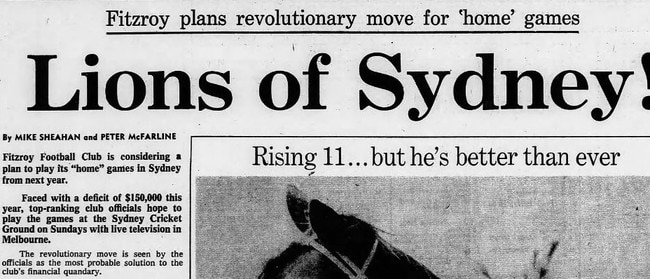
“Today has dented the whole idea of us coming to Sydney on a permanent basis.
“We were supposed to have been adopted by the people here as the ‘Sydney Lions’ but where was this support today?”
A dose of short-termism about the on-field loss may have also tainted his views.
“Three kicks covered the ground from end to end,” Bibby said about the smaller SCG playing surface.
“This does not seem suitable for our style of football.The whole idea of Fitzroy playing in Sydney must be revised.”
Behind the scenes though, Bibby continued the push all the way through to 1980 when the ‘Roys were broke. He and one half of the board resigned amid a hostile club meeting where the Sydney idea was shouted down by supporters.
Wiegard favoured staying amid a turbulent time.
“You’d speak to five generations of supporters,” he says.
“With that all stuck in your head it was really hard to think about moving interstate.
12 months later there were similar scenes at South Melbourne but the Swans ultimately flew north to take Fitzroy’s original place as Sydney’s team.
Ownership disaster
The game’s flirtation with private ownership had its greatest effect in Sydney and the newly created Brisbane team.
In the space of 12 months the VFL made the fundamental mistake of selling club licences to the flashy buyer with the bigger offer rather than the more solid alternative.
In Sydney it was the infamous Doctor Geoff Edelsten instead of Basil Sellers.
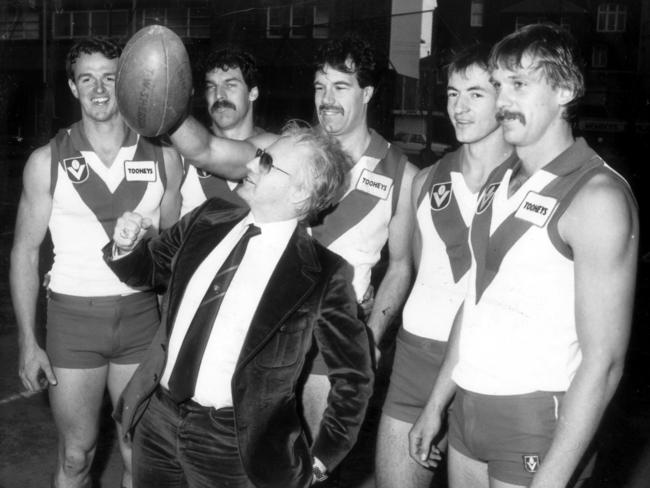
In Brisbane it was TV star Paul Cronin with the help of the even more infamous tycoon Christopher Skase, instead of the successful tennis promoter and businessman John Brown.
By the start of the 1990s both clubs had collapsed when they couldn’t make a dollar and the original money promised never eventuated.
Further owners were found and they fared no better.
With no wins, money or hope, the Swans and Bears were the biggest headache for football in the late 1980s and early 1990s, and almost caused the national push to be abandoned.

The East Coast Bears
It was the meeting that would decide the future of the AFL where clubs would decide whether to fund the Sydney Swans to stay alive. Again.
Not many were keen to do that, but one AFL’s alternative was to have Carlton play home games in Sydney was more unpalatable.
A thor option then emerged, amalgamating problem children Brisbane and Sydney.
“We said ‘well we could always merge Brisbane and Sydney’..knowing full well we wouldn’t get a yes. But we were just trying to throw options in to give the clubs something to think about,” then-AFL CEO Ross Oakley told the author in 2018.
Then Swans chair Peter Weinert thought that it was a more realised plan, saying that the AFL were still trying to get him to accept the Brisbane deal right before the vote as they weren’t confident of another rescue package.
A merged team would have seen the club play half their home games in Sydney and half in Brisbane, wear the Swans’ colours and adopt a name like the East Coast Bears or Northern Bears.
It was ultimately foiled as the Swans were saved, but both Sydney and Brisbane clubs reverted to traditional membership structures.
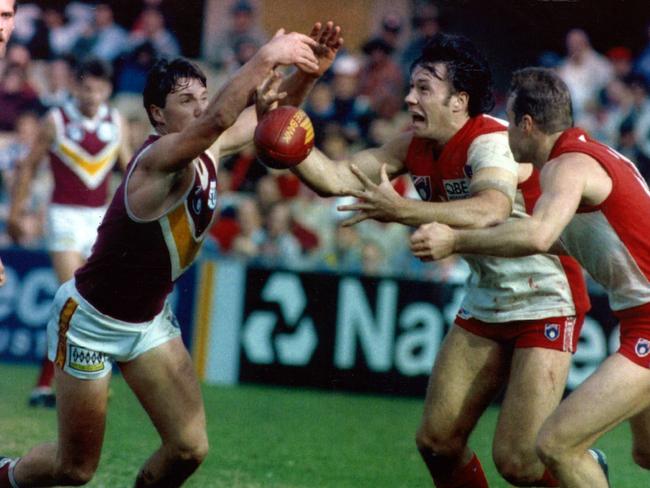
The Melbourne connection
The controversial merger of Fitzroy and Brisbane, left both the Sydney and Brisbane clubs with a Victorian heritage and supporter base that had varying views on embracing the new name and colours.The circumstances of the Fitzroy removal always made the Lions task more problematic.
Yet winning helps.
Brisbane’s 2001-02-03 threepeat premierships were a healing process for many old Fitzroy supporters who took up the new Lions cause.
The Swans premiership in 2005 was celebrated as the breaking of the biggest drought in VFL/AFL history with as much gusto in Melbourne as it was in Sydney.
Now the two clubs with the shared history meet as northern pioneers, with a swag of newly created fans and an army of generational support in the code’s spiritual home.
As Australia’s three biggest cities unite for the first time on footy’s biggest day, it makes for perhaps the most historically interesting Grand Final we’ve ever seen.



